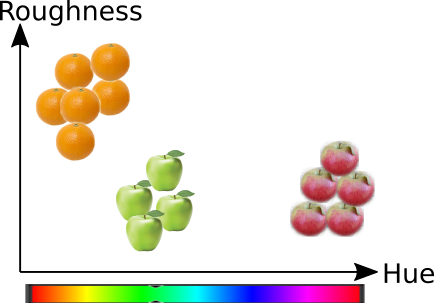14. Decision trees and forests #
14.1. Decision tree #
Decision trees are non-parametrized methdos for supervised learning, which can be used both regression and classification. The decision tree below is trained to classify the pixels in the satellite image. From all 13 features (channels of the image), it uses only 4 features, which are {5, 11, 12, 7}. First the feature number 5 is used for thresholding. If it’s value is less than 0.0751, then the sample is classified as water. From the description of the channels, we can check that the channel 5 describes the reflectance of wavelength of red (740 nm). The reason for this threshold can be interpreted with relative ease, in this case it is because water absorbs red light, and there is no other area where this absorbtion would be stronger. Therefore this measurement alone separates water areas from every other.
If the sample is not water, the channel 11 (1375 nm) will be compared next, and if it’s reflectance is very small, the area is classified as forest, and so on.
More information from SKLearn documentation of Decision trees.
The advantages of decision trees is that
The are simple and easy to interpret
They are nonparametrized and do not depend on the distribution of data (no Normal distribution or euclidean distances necessary)
They can handle categorical data
Prediction can be made in logarithmic time
Can also utilize categorical variables
Disadvantages
Can create too complex models which do not generalize well
The structure of the tree can be very different if the data is only slightly different
The datasets used for training should be balanced (similar number of samples in all classes)
The learning methods are known to be complex (NP-complete), and therefore the structure is usually search using heuristic algorithms which does not guarantee the optimality of larger trees
To mitigate the disadvantages of decision trees, a group of shallow decision trees are often used instead of one large. Methods which combines many simple classification or regression methods together to achieve better results are called as ensemble methods. Ensembles can be used in parallel (bagging) or in series so that the next method improves the results of the previous instance (boosting). The ensembles of simple decision trees are currently very usefull methods. For example the famous XGBOOST library is a good example of this. More about ensemble methods later in this material.
import numpy as np
import matplotlib.pyplot as plt
import seaborn as sns
sns.set()
from sklearn import datasets, metrics
from snippets import plotDB
from sklearn.model_selection import train_test_split
from sklearn import tree
X,y=datasets.make_blobs(n_samples=200, centers=3, n_features=2, random_state=0, cluster_std=1.1)
X_train, X_test, y_train, y_test = train_test_split(X,y, test_size=0.25)
dt = tree.DecisionTreeClassifier(max_depth=2)
dt.fit(X_train, y_train)
print("Accurary in the training set..%f" % metrics.accuracy_score(y_true=y_train, y_pred=dt.predict(X_train)))
print("Accurary in the test set......%f" % metrics.accuracy_score(y_true=y_test, y_pred=dt.predict(X_test)))
print(dt)
tree.export_graphviz(dt, 'dt.dot', filled=True, rounded=True)
plotDB(dt, X_train, y_train)
Accurary in the training set..0.946667
Accurary in the test set......0.880000
DecisionTreeClassifier(max_depth=2)
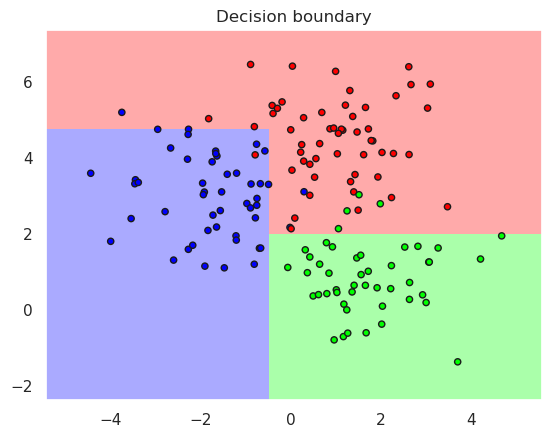
Each branch in the decision tree creates new linear separation in the remaining are of the feature space. Try to increase the depth of the tree in the previous code cell to see how the decision boundary changes when the complexity is changed.
14.1.1. Optimize the tree depth#
Obviously too deep tree leads to too complex decision boundary and overfitting. Bu what is the optimal tree depth? It can be optimisez using cross validation, as shown below.
from sklearn.model_selection import cross_val_score
N=6
train_score=np.zeros(N)
test_score=np.zeros(N)
cv_score=np.zeros(N)
depth=np.arange(N)+1
for i in range(N):
dt = tree.DecisionTreeClassifier(max_depth=depth[i])
dt.fit(X_train, y_train)
train_score[i]=metrics.accuracy_score(y_train, dt.predict(X_train))
test_score[i]=metrics.accuracy_score(y_test, dt.predict(X_test))
cv_score[i] = cross_val_score(dt, X_train, y_train, cv=5).mean()
plt.plot(depth, train_score, label="Train score")
plt.plot(depth, cv_score, label="CV score")
plt.plot(depth, test_score, label="Test score")
best_depth=depth[cv_score.argmax()]
print("Best depth value is %f" % best_depth)
plt.legend()
print("Accurary in the test set......%f" % cv_score.max())
Best depth value is 2.000000
Accurary in the test set......0.920000
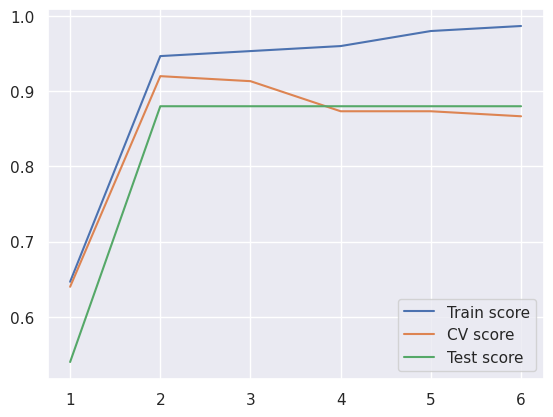
It seems that two is the optimal depth of the decision tree, since after that the accuracy of the cross validation is not increased any more.
The accuracy in the training set increases up to 100%, untill every point is in its own leaf, but that is only overfitting to the training data
Test score shows the same message than cross validation
Therefore do not use test data in optimising the model. Use it only in the end, when you have selected the optimal model using cross validation
Red more from Skikit Learn
14.2. Ensemble methods #
Bagging in Skikit Learn
A subset of the training data is selected and a full decision trees or other classifier is trained for it
The output of all predictors in the bag are then aggregated by voting, averaging or other methods
This method reduces the variance in the predictor generation process by introducing some randomness
Boosting is another method to combine multiple predictors
14.2.1. Bagging #
14.2.1.1. Randomized trees #
Forest of randomized trees is one famous bagging method. it works as follows
A random partition of data is drawn from the training data to bootstrap the tree structure
The tree may use all features or only a random subset of available features
The output is again aggregated from all predictors
The two sources of randomness stabilizes the tree structure and reduces overfitting
Read more from Skikit Learn
14.2.1.2. Extratrees classifier (Extremely randomized trees)#
Even more random
The threshold rules are selected at random for randomly selected features
The best thresholding rules are voted
Read more from Skikit Learn
14.2.2. Optimising the parameters fo the Extratrees classifier#
Extratrees classifier has already many more parameters than normal decision tree.
It is not convenient to try them all to find out an optimal combination
Hand made optimisation loop with cross validation can be used as shown previously to make exhaustive search
There is also better method in Scikit Learn, called as
GridSearchCVIt uses an optimisation algorithm and CV to find out optimal parameters
First we just need to define which variables are going to be searched and in which range
Then we let the optimisation algorith to tune the predictor and we just used the optimal version
Note that we already got higher accuracy than with using a single tree predictor
from sklearn.ensemble import ExtraTreesClassifier
from sklearn.model_selection import GridSearchCV
X,y=datasets.make_blobs(n_samples=200, centers=3, n_features=2, random_state=0, cluster_std=1.1)
X_train, X_test, y_train, y_test = train_test_split(X,y, test_size=0.25)
et = ExtraTreesClassifier(max_depth=5, min_samples_split=2, n_estimators=9)
et.fit(X_train, y_train)
# Set the parameters by cross-validation
tuned_parameters = [{'max_depth': range(3,10), 'min_samples_split': range(2,5),
'n_estimators': range(5,30)}]
# Use the GridSearch to find out the best paramers using 5 fold cross validation
tune_et=GridSearchCV(et, tuned_parameters, cv=3);
tune_et.fit(X_train, y_train);
optimal_et=tune_et.best_estimator_
print("Accurary in the training set..%f" % metrics.accuracy_score(y_true=y_train, y_pred=optimal_et.predict(X_train)))
print("Accurary in the test set......%f" % metrics.accuracy_score(y_true=y_test, y_pred=optimal_et.predict(X_test)))
print(optimal_et)
Accurary in the training set..0.946667
Accurary in the test set......0.880000
ExtraTreesClassifier(max_depth=4, n_estimators=21)
plotDB(optimal_et, X_train, y_train)
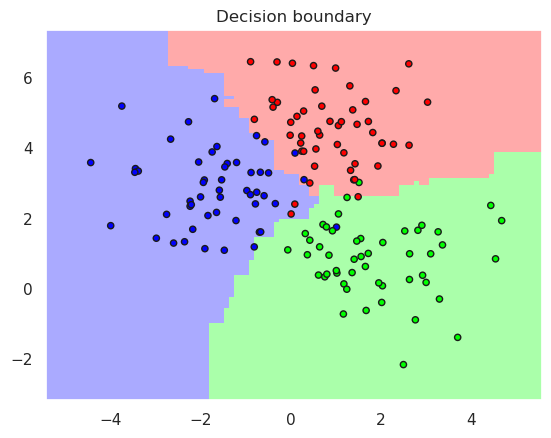
14.3. Boosting #
Construct weak random trees and chain them after each other on modified version of the data
Examples Adaboost Gradient Tree Boosting XGBoost
14.3.1. Adaboost #
First create one weak predictor, which is perhaps only slightly better than guessing
Assign equal weight \(w_i=1/N\) to each of the N samples
Repeat following boosting iteration M times:
Try to predict the data with one weak predictor
Find out which samples were incorrectly classified, and increase their weights, decrease the weights of correctly classified samples
Train the next predictor with the weighted data so that it concentrates especially to those samples which were difficult for the classifiers this far.
The final classification result is voted by the predictors
First publications |
|---|
Freund, Y., & Schapire, R. E. (1997). A Decision-Theoretic Generalization of On-Line Learning and an Application to Boosting. Journal of Computer and System Sciences, 55(1), 119–139. https://doi.org/10.1006/jcss.1997.1504 |
Drucker, H. (1997). Improving Regressors using Boosting Techniques. ICML. |
Hastie, T., Rosset, S., Zhu, J., & Zou, H. (2009). Multi-class AdaBoost. Statistics and Its Interface, 2(3), 349–360. https://doi.org/10.4310/SII.2009.v2.n3.a8 |
14.3.2. Gradient Tree Boosting #
Also called as Gradient Boosted Regression Trees (GBRT)
Improved version of Adaboost
The predictor is an aggregation of many weak individual predictors, often small decision trees, like in Adaboost
The main difference is that the boosting in GBRT:s is implemented as an optimisation algorithm
The target of the optimisation is to minimize the Objective function
The model fitness involves minimization of th training loss and model complexity (Regularization term)
Training loss function is often a squared distance \(L(\hat{y}_i,y_i) = (\hat{y}_i -y_i)^2\)
Regularization term is usually either
\(L_2\) norm: \(\Omega(w)=\lambda \Vert w \Vert ^2\) or
\(L_1\) norm: \(\Omega(w)=\lambda \vert w \vert\)
Optimizing training loss improves the prediction capability of the model, because it is hoped that the predictor will learn the underlying distributions
Optimizing regularization encourages simples modes. They tend to predict better for future data, since simpler methods do not suffer from overfitting as easily as complex models
Read more from Interesting slides about gradient boosting
First publications |
|---|
Breiman, L. (1997). Arcing the edge. Technical Report 486, Statistics Department, University of California at …. |
14.3.3. Extreme Gradient Boosting (XGBoost) #
A library implementing Gradient Tree Boosting
Available for many programming languages
Read more from XGBoost Tutorials
First publications |
|---|
Friedman, J. H., Hastie, T., & Tibshirani, R. (2000). Additive logistic regression: A statistical view of boosting. https://doi.org/10.1214/aos/1016218223 |
Friedman, J. H. (2001). Greedy function approximation: A gradient boosting machine. The Annals of Statistics, 29(5), 1189–1232. https://doi.org/10.1214/aos/1013203451 |
Friedman, J. H. (2002). Stochastic gradient boosting. Computational Statistics & Data Analysis, 38(4), 367–378. https://doi.org/10.1016/S0167-9473(01)00065-2 |
Chen, T., & Guestrin, C. (2016). XGBoost: A Scalable Tree Boosting System. Proceedings of the 22nd ACM SIGKDD International Conference on Knowledge Discovery and Data Mining - KDD ’16, 785–794. https://doi.org/10.1145/2939672.2939785 |
from sklearn.ensemble import GradientBoostingClassifier
bt = GradientBoostingClassifier(n_estimators=9, learning_rate=1, max_depth=1, random_state=0)
bt.fit(X_train, y_train)
print("Accurary in the training set..%f" % metrics.accuracy_score(y_true=y_train, y_pred=bt.predict(X_train)))
print("Accurary in the test set......%f" % metrics.accuracy_score(y_true=y_test, y_pred=bt.predict(X_test)))
print(bt)
plotDB(bt, X_train, y_train)
Accurary in the training set..0.973333
Accurary in the test set......0.920000
GradientBoostingClassifier(learning_rate=1, max_depth=1, n_estimators=9,
random_state=0)
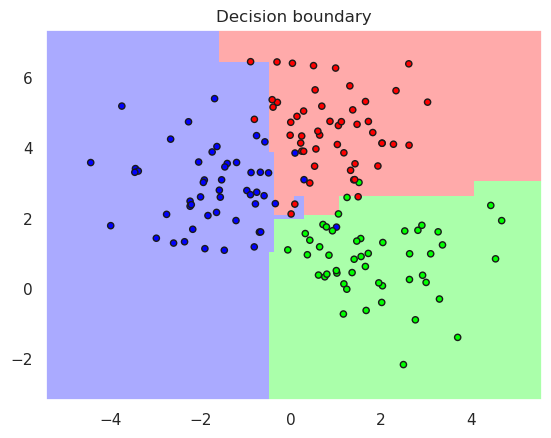
plotDB(bt, X_train, y_train)

